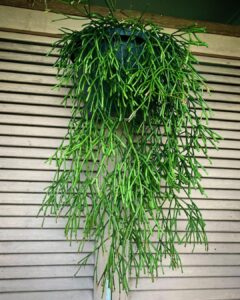Discover the secrets of Dancing Bones Cactus Care with expert tips and guidance. Learn how to nurture Hatiora Salicornioides in your home.
Explore how to care for Dancing Bones Cactus. Discover essential tips and techniques to help you grow and maintain this fascinating cactus, adding beauty and life to your home or garden.
Common Names: Spice Cactus, Bottle Cactus, Dancing Bones Cactus, Drunkard’s Dream
Botanical Name: Hatiora Salicornioides
USDA Zones: 9-11
Check Boobie Cactus Care Guide
Dancing Bones Cactus Profile

Also known as Drunkard’s Dream, the dancing bones cactus (Hatiora salicornioides) is a small cactus plant with thin, segmented stems. During spring, it produces beautiful deep yellow-orange flowers on the ends of its bottle-shaped stems.
The Hatiora salicornioides is originally from Brazil and is not a desert cactus but rather a plant that lives on other plants in the rainforest. Its stems do not have thorns, although older plants may have a few spiny growths at the bottom. A fully grown dancing bone cactus can be 12 to 18 inches tall (31-46 cm).
It can only grow outdoors in specific regions with warm climates (USDA plant hardiness zones 9-11), but people in cooler areas can still have this tropical plant indoors.
Check Star of Bethlehem Flower Care
Dancing Bones Cactus Propagation
- Dancing bones cactus plants can be easily grown by taking cuttings from a healthy, well-established plant. Do this process during late spring or early summer, a time when the plant is in its peak growth phase.
- You can do this by cutting off segments of the stems, which will usually start growing roots right away.
- To propagate them, just plant these cuttings in a pot filled with a special soil mix for cacti and succulents or a regular mix with a little bit of coarse sand mixed in.
- Make sure the pot has a hole at the bottom for water to drain out.
- Remember, dancing bone cacti, like all cacti, can suffer from rot if they are kept too wet.
Check Piper Betel (Paan) Care
Growing Conditions for Dancing Bones Cactus

Light
Keep the dancing bones cactus in a spot where they receive light that is not direct sunlight. Make sure to protect the plant from the strong afternoon sunlight.
Check Anthurium Wendlingeri: Growing and Care Guide
Soil
The dancing bones cactus likes soil that drains well and keeps some moisture. You can make the right soil by mixing sand, loam, and peat together. Another option is to use a special soil mix made for cacti that you can buy at the store.
To help the soil drain even better, you can add things like perlite, pumice, or coarse sand to the mix.
Check Moonflower Care
Water
Water your dancing bones cactus every two weeks or every week in the summer. Let the soil dry out about 4-5 inches before giving it a good soak. During winter, water much less and let the plant almost completely dry before watering again. This cactus can handle a bit more water than usual, but don’t let it sit in soggy soil.
Check Ashwagandha Care
Temperature
When it gets colder, and the temperature drops to around 50°F (10°C), it’s a good idea to bring Hatiora salicornioides inside your home. These cacti grow best in moderate room temperatures. So, it’s recommended to keep them indoors where the temperature stays in the right range for their growth.
Check Annatto Achiote Care
Dancing Bones Cactus Care

Fertilizer
During the growing season, feed your dancing bones cactus every two weeks with a balanced, water-soluble fertilizer. Make sure to dilute the fertilizer to half-strength before using it.
Read about Salsify Care in Pots
Repotting
For young Hatiora salicornioides plants, it’s best to move them to a new pot every year right before spring starts. Older plants usually need to be repotted every two to three years.
To help the plant grow bigger, always put it in a larger pot with holes at the bottom for water to drain out. This lets the roots grow well and stops too much water from collecting, making a good environment for the plant to grow and stay healthy.
Read about Dischidia hirsuta ‘Red Leaf’ Growing Tips & Care Information
Winter Care
The dancing bones cactus become dormant in winter. Water it occasionally to prevent the soil from drying out completely. Don’t give it any fertilizer until spring comes, and then you can start taking care of it as usual.
Read about Haworthia Retusa Care
Pests and Diseases
Watch out for common pests like mealy bugs and spider mites. Check for pests once a week when you water your cactus. Keep a bottle of Insecticidal Soap handy so you can easily treat any pests you find.
Be careful not to water the plant too much because that can cause the leaves to turn yellow or fall off. Pay attention to how much water the plant needs and reduce watering if necessary.
Read about Haemanthus Coccineus Care
Dancing Bones Cactus Toxicity
The sap of the Hatiora salicornioides plant is poisonous, so it’s important to keep it away from animals and make sure they can’t reach it.
Read about Blue Passionflower Care



